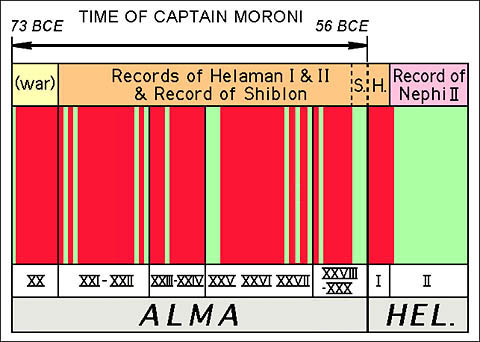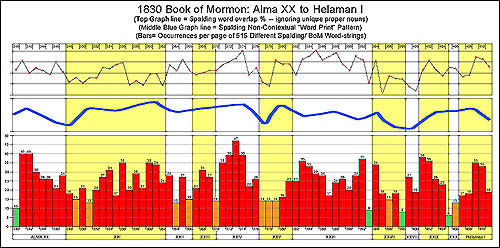Dan Vogel wrote:
I would like to see you make your case here. In looking at the various links, I found your presentation
of your evidence difficult to follow and analyze. So I think it would be helpful if you show here step-by-step
exactly how you decide what is a Spalding word string.
I began this on-again, off-again 30-year study when I inherited a list that Vernal Holley had compiled for his
little volume, "Book of Mormon Authorship." Due to mounting publication costs and a need to reduce the size
of that publication, Vernal gave me several folders of his discarded study materials. A couple of years before
he finally got his first edition together, I submitted his list as an illustrative supplement to a working paper I
prepared for Richard P. Howard. When Howard expressed no particular interest in the subject, I recycled the
list as part of my 1979 grant proposal to Jeffery Holland:
http://solomonspalding.com/SRP/SRPpap01.htm#pg56a
http://solomonspalding.com/SRP/SRPpap01.htm#pg69a
Exactly how Vernal compiled his list, he never said. What he did tell me, was that he was not about to waste
his time, marking up his LDS edition of the Book of Mormon and his 1910 edition of Spalding's story, by
underlining such trivial textual parallels as "it is," or "they went," or "but behold!"
The first examples of what Vernal termed "significant word affinities" that I recall him pointing out to me, were:
Spalding: those who shall die... in the cause of their country and their God
B. of M.: they have died in the cause of their country and of their God
Spalding: Determined to conquer or die,
B. of M.: they were determined to conquer in this place or die
Spalding: It is impossible to describe the horror of the bloody scene . . .
the blood and carnage
B. of M.: It is impossible... to describe... the horrible scene of
the blood and carnage
I recall not being overly impressed with the examples he shared with me. I supposed that the word-strings
shared by the two texts (which for some reason had caught his attention) could be explained as coincidences.
Later, when I set about compiling new lists of my own from scratch, I called upon the computer programming
skills of an old Michigan friend, the late Bill Williams. In the days before e-mail, Bill would send me packages
of mainframe computer print-outs, listing thousands of two-word and three-word combinations he had
discovered were shared by both texts. The vast majority of these extracts were of the "it is," and "they went"
variety of word-string identities, but occasionally Bill would happen upon a dozen or so words strung out in
the approximate same order in both texts, frequently interrupted in their identity by extraneous modifiers, etc.
I am thus the recipent of lengthy compilations from those two old friends, and have only needed to resort to
my own wits, in uncovering a few hundred more, rather mundane examples, to help flesh out my color-coded
"Book of Solomon" html file, here:
http://solomonspalding.com/SRP/MEDIA/BookSol0.htm
To locate additional word-strings (which Vernal and Bll had either missed or never given to me), I simply used
the search function in a word-processing program in which I had opened both source documents at once. The
task was a tedious one -- but was mostly completed in one weekend of home computer work.
The problem with the html coding, is that the underlining function (which I've used to indicate word-strings)
will not display a double underline. Thus, where I have located overlapping word-strings, I cannot show their
overlap easily in a web-page.
Hopefully the above explanation provides some insight into how I developed the 515 word-strings used in
the construction of my "Book of Solomon" charts. I long ago donated my old, hand-typed compilations used
for reference in writing my graduate studies project papers and constructing their charts, to the Marriott Library
in SLC. If you are curious to see by-products of those parallels compilations, look at the color-coded underlinings
in my own LDS Book of Mormon and LDS 1910 Spalding edition (which are mostly duplications of Vernal's earlier work):"
http://solomonspalding.com/SRP/MEDIA/SRPpap16.htm
http://www.solomonspalding.com/docs/lds1910a.htm
The big question I have left unanswered, is "What is a SIGNIFICANT textual parallell?" For some types of statistical
analysis, every single word-string in a text must be tabulated and reviewed. Obviously this can only be easily
accomplished by dedicated, automatic computer comparisons software. In such cases, "significance" is generally
a mathematically derived value, indicating the highest occurring deviations from a mean, or median, or some
other accepted baseline figure. In such as case, perhaps a ten-word phraseology parallel, with the identical words
occurring in the same order, found only in a Shakespeare play and a pre-existing Earl of Oxford diary, might
be considered "significant" because of its perceived one-in-a-billion chance of popping up in two unrelated sources.
Then again, if that same ten-word phraseology parallel were later discovered to have pre-dated both sources,
and to have been a part of a widely-circulated invitation to the Queen's birthday celebration -- then the ultimate
"significance" of the oddity might fade considerably for students of Shakespearean play origins.
So, hopefully I've exhausted your patience with this long answer, and will not have to reveal all of my stage
magician's secrets in this public forum.
UD

